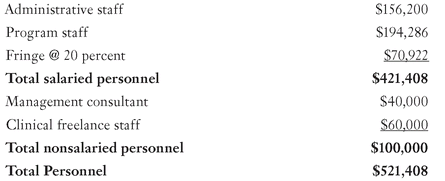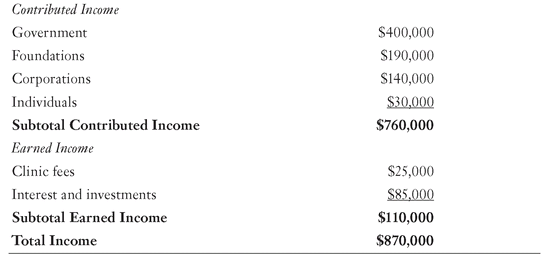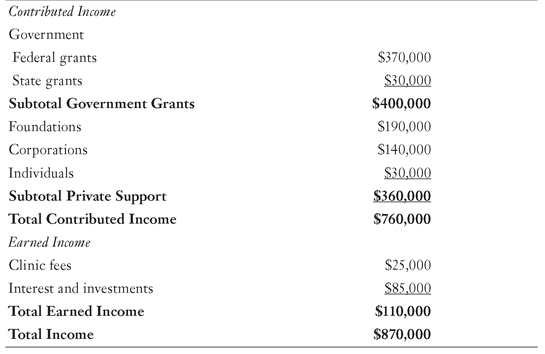Organizational Budget
Proposals will also require an organizational budget, which includes all your charity’s expenses for every program as well as general operating expenses. An organizational budget follows the same general format as the program budget, but you use a condensed personnel budget rather than list the salaries of every single person who works for your charity.

DEFINITION
Organizational budgets represent your charity’s total operations, including all personnel (fundraising staff, too) and expenses and all sources of income. If you’re writing a proposal for general operating support, the program budget and your organizational budget are one and the same.
The personnel section could look like one of the following examples.
Example 1

Example 2

The second example makes clear the relationship between administrative and program personnel costs—in this case, administrative salaries are only around 10 percent less than those for program staff. If accompanying a program proposal, this might look like too little (relatively speaking) was being spent on programs, so you might not want this breakdown. For a GOS proposal, however, the relationship might present a good argument for increased support of general operations.
Your financial officer should prepare the organizational budget for you, but you’ll probably want to do some additional formatting. Just as you did with the program budget, you’ll want to group similar activities (such as making regrants or running a clinic) and subtotal them so they tell the story you need to reinforce the message in your narrative.
Income in an organizational budget is usually broken down by type of funder rather than specifying individual ones. For large organizations, you might break down the types into subgroups to make a point about where your funding comes from. Here are two examples to illustrate what I mean.
Example 1

Example 2

Whether income is contributed or earned is pretty clear except, perhaps, with corporate contributions. Most charities list corporate grants under contributed income. Corporate sponsorships, however, are usually listed as earned income.

HOW TO SAY IT
One of my pet peeves is the use of the term unearned income to categorize donations. What’s unearned about it? We fundraisers work very hard to earn it, as does the program staff to create and run programs worthy of donations. A more accurate description is contributed income.
By breaking down the sources of the government support, the charity’s significant dependence on federal support becomes clearer, illustrating the need for greater support from other sectors. To dramatize a need for general operating support, the budget narrative might contrast the amount of support received for programs versus operating expenses.
Of necessity, budgets are frequently the last part of a grant proposal you will prepare. Don’t let your rush to get the proposal in cause you to present a budget that’s not in sync with the proposal narrative, or one that does not reinforce the narrative’s most important points. Get help when you need it from program and finance staff. You’ll find more budget examples in Chapter 21, where I cover grant reports.
And last but certainly not least, check your formulas! No matter if you or someone in your finance department prepared a budget, check and double-check the formulas in your spreadsheet. A mistake in the budget can call into question the veracity of your entire proposal.
You will find a Budget Builder workbook for a project grant at idiotsguides.com under “Book Extras.” It includes a personnel worksheet and a calculator for indirect expenses that feed into the main budget worksheet.
The Least You Need to Know
• Your budget should describe in numbers the activities included in your narrative.
• Include part of the salary of everyone who will work on a program and state the percentage of their time next to their title.
• Include numbers for the expenses for who, what, when, where your program will need as well as how you will pay for them.
• Figure your indirect costs by adding up everything that’s not directly related to a program and then dividing that number by your total budget.
• If permitted by the funder, always include indirect expenses, using your indirect rate multiplied by your total direct expenses.
• Use footnotes or a budget narrative when your numbers require context and explanations to be effective, or when the funder requests an explanation in some form. Explaining the largest numbers in your budget in a footnote or narrative is also a good idea.
..................Content has been hidden....................
You can't read the all page of ebook, please click here login for view all page.
